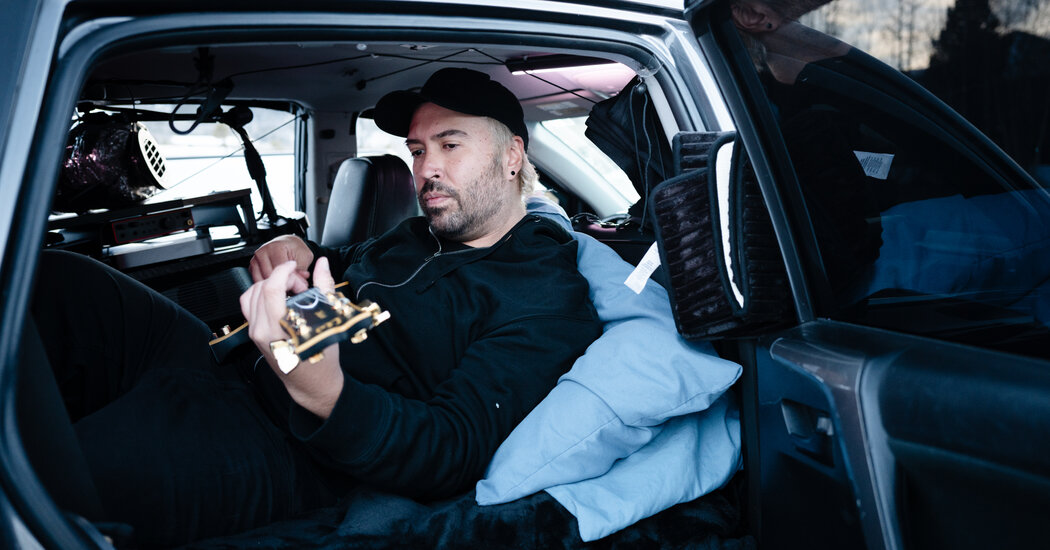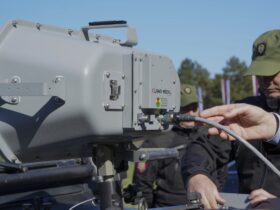On the side of a highway leading to some of the most coveted slopes in the world, in a parking lot covered in snow, a form of affordable housing has emerged.
Here in cars, trucks and vans, behind foggy windshields and zipped in sleeping bags, those who serve the vacationers who come to enjoy the snow tried to fall asleep on a recent night — two ski instructors, two snow plow drivers, a ski lift operator, an ice fishing guide, a dog sledding guide, the employee of a ski resort whose job includes scanning ski passes, two ER nurses who treat their injuries, a cashier at a drugstore, multiple servers at local restaurants, as well as Kristine Litchfield, who earns $24 an hour at a ski shop fitting people for their boots.
At 6 a.m., the 62-year-old woke up under multiple blankets in the bunk bed she built in the back of her Ford T250 van. It was negative 8 degrees. “It didn’t feel chilly at all,” she joked.
What Ms. Litchfield and the more than two dozen others sleeping in their vehicles that night really needed — the requirement for the right to sleep in the subzero cold in a landscape that looks like a snow globe — was a local pay stub.
As homelessness soars to the highest level on record, parking lots like this one have opened from coast to coast, offering a refuge to those who no longer have a house to sleep in, but still have a car.
But the backlash from neighbors has often been fierce, and to circumvent that, municipalities have imposed an ever greater number of rules on the parkers. The lot in the town of Frisco — a 30-minute commute to Vail, 14 minutes to Breckenridge and nine minutes to the powder of Copper Mountain, where the U.S. ski team trains — appears to be the only lot in the country that requires those who sleep there to prove that they are part of the local economy.
In the public imagination, homelessness looks like the man in soiled clothes sleeping on top of a subway grate or the woman peering out of a tent from under a highway overpass. But in cities and towns that have the highest concentrations of homelessness, many — and sometimes a majority — of those who do not live in shelters are in cars, not on the streets, according to the annual census known as the “point in time count.”
In Los Angeles County, for example, two-thirds are living in vehicles. In San Mateo County, which includes part of Silicon Valley, it’s even more — 71 percent.
“The American dream of owning a home is dead unless you make a gazillion dollars,” says Ms. Litchfield, sitting in the front seat of her van.
Her shift at the ski shop starts at 7:30 a.m. in a nearby strip mall. Customers are already queuing, hoping to hit the slopes of some of the most coveted runs in the world. The vacationers wait behind a cordon like in an airport line, then step onto a small platform towering over Ms. Litchfield who measures their feet and proposes a boot size.
Ms. Litchfield spends another part of her seven-hour shift redoing a display of North Face jackets, then sells a customer hand warmers and a pair of goggles to another before heading back to the lot.
Though she makes more than Colorado’s minimum wage of $14.81 an hour, the $2,874 she earns each month is not enough to afford more than a windshield between herself and the majestic snow. According to Zillow, studios here rent for $2,500 a month — meaning that Ms. Litchfield would need to spend 87 percent of her income on rent, leaving too little to pay for her other needs.
Homeownership is even further out of reach as the median sales price hovers near $1 million.
“We cannot afford to buy a home, and so people started to think, well, screw it,” she said. “Why should I put myself in that much debt just to live in a house? And so that’s how come people are here,” she said gesturing through the icy windshield at the snow-covered asphalt. “This is the American dream. Living in a van. Living in your car,” she said.
Affordable housing activists are being joined by employers in pushing for parking lots like the one where Ms. Litchfield lives. Local business owners struggle to hire and to retain workers in Summit County, where Frisco is and which was once ranked the sixth wealthiest county in the United States.
Waitresses live three and four to an apartment, and at the ski resorts, J-1 visa holders, designed for guest workers from abroad, share bunk beds.
Andrew Aerenson, a former board member of the Frisco Town Council sees the parking lot as having created affordable housing at virtually no cost to the city: “We sit around and have constant conversations about work force housing,” says Mr. Aerenson, a retired lawyer and a ski instructor at Breckenridge, who estimates that it costs the town $150,000 in subsidies to build a single unit of affordable housing, a process that takes years even when the funds are available.
“This is a no-brainer for me,” he said of the parking lot where workers pay $75 a month to rent their spot, a fee that offsets costs including the portable restroom. “We want these people here.”
The lot here has been in existence for nearly six years, its location moving from a church to a marina to a library.
Though its model has been copied elsewhere, other communities have not been as welcoming, and similar programs have failed after pushback from homeowners.
After opposition by neighbors, two similar lots, one that opened in 2022 in a river-rafting town in Colorado, and the other that was scheduled to open in 2024 in a hiking destination in Arizona, were closed. Both lots required proof of employment.
“Imagine talking to your grandma about this thing that you want to do, and every single little fear that pops into her brain, suddenly you have to address,” said Salty Riggs, who helped create the lot in the river rafting town of Salida, Colo. The location next to a park with room for 15 vehicles was approved in 2022, and operated for two years before quietly closing, after the list of rules became so long and onerous that parkers began to feel unwelcome, she said.
In Sedona, after the City Council approved a zoning change in the spring of 2024 that would have allowed homeless workers to park in a public lot, enraged residents organized a referendum that shut it down a few months later, before anyone parked there.
To survive in Frisco, the organizers of the lot from a group called Unsheltered in Summit have treaded lightly and have tried to make sure the lot blends into the landscape.
Its discretion is outlined in a PowerPoint presentation that the organizers whip out when necessary for elected leaders or members of the local rotary club. The first few slides show a drug addict collapsed on the pavement and a derelict van with boarded up windows. A subsequent slide shows one of the neat and tidy lots in Frisco. One of the areas used also serves as a parking lot for the town’s utility vehicles, so a visitor happening across the lot would have a hard time distinguishing which cars are inhabited, and which are not.
To the side is a portable toilet. A new, brightly painted dumpster has a combination lock. Parkers are given the code only if they are approved.
Another slide makes the point that organizers most want to get across — the parking lot at midday is empty, because its residents are working.
Paul Minjares, the 41-year-old guitarist, is working on organizing an “open house” with members of the community. “Basically, to show that it’s not skid row,” he said.
He makes additional money by working as the intake coordinator, whose duties include managing the lot and vetting applicants. He conducts a lengthy interview process, first by phone and then in person, looking for a red flag indicating that the person is not working. The applicant can provide a pay stub, or a letter of employment.
Mr. Minjares has lived in the lot for three years, and like some of the other car dwellers, he said there is a newfound freedom in not having to pay rent, allowing him to save at the same time that he is able to live in a place of stunning alpine beauty. A nearby recreation center provides the parkers a place to shower, as well as multiple pools, a hot tub and a steam room.
When he interviewed Ms. Litchfield two years ago, he sat in her van to get to know her, and she later provided an email from the ski shop indicating her start date.
Before she goes to sleep, Ms. Litchfield blasts hot air into the van. A piece of Velcro across the ceiling of the van allows her to hang a curtain, trapping the heat in the back. “I heat the van up, and then I was telling you about the cloth that I put up? So, it’s right over your head, here. So that pulls down,” she said, explaining how she partitions the space.
She puts on her fuzzy socks and multiple layers of clothes. “Once I crawl up into my bunk, I close the curtains. So now you have all the hot air which rises in the back of the bunk with me in there and me with my sweats and my fuzzy blankets and a feather duvet and a fuzzy pillowcase and then if I get cold in the middle of night, let’s say I woke up, it’s three in the morning, and I’m like, ‘Damn, it’s really cold in here.’ I just get up, drop the cloth, turn it on. Heat it up,” she said, explaining her nightly ritual.
An Electric Blanket
Beside her, Mr. Minjares is getting ready for bed too. An intricate contraption he has created using a hitch on the back of his RAV4 pumps hot air from a diesel heater, through a duct, into one of the windows of his car, cracked open just wide enough to let the duct through. It’s toasty inside.
But as the snow fell, he realizes that a woman in a pickup truck is struggling.
The 45-year-old cashier at Target ended up in her Toyota Tacoma after her building was sold and her rent doubled. Now, Maegan DePriest crawls into the bed of the truck covered by a camper shell, its fiberglass skin the only barrier separating her from the howling wind outside. A small propane heater allows her to warm herself, but she is afraid to fall asleep with it on — could she be a victim of carbon monoxide poisoning?
To get her through the night, Mr. Minjares lent her an electric blanket, which she plugged into a power strip, powered by a rechargeable battery. “It helped a lot,” she explained. “Like I said, it hasn’t been easy.”
The next morning, she wakes up to head to her job at Target, where she makes $22 an hour.












Leave a Reply